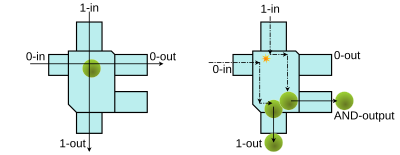
A billiard-ball computer, a type of conservative logic circuit, is an idealized model of a reversible mechanical computer based on Newtonian dynamics, proposed in 1982 by Edward Fredkin and Tommaso Toffoli.[1] Instead of using electronic signals like a conventional computer, it relies on the motion of spherical billiard balls in a friction-free environment made of buffers against which the balls bounce perfectly. It was devised to investigate the relation between computation and reversible processes in physics.
- ^ Fredkin, Edward; Toffoli, Tommaso (1982), "Conservative logic", International Journal of Theoretical Physics, 21 (3–4): 219–253, Bibcode:1982IJTP...21..219F, doi:10.1007/BF01857727, MR 0657156, S2CID 37305161.